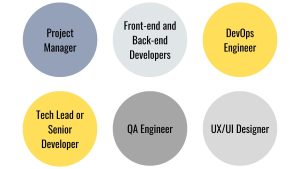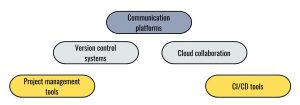Dedicated Team of Engineers: From Selection to Launch
Introduction In today’s fast-paced digital landscape, the success of a product or service often depends on the quality and effectiveness of its engineering team. Whether you’r...

Introduction
In today’s fast-paced digital landscape, the success of a product or service often depends on the quality and effectiveness of its engineering team. Whether you’re building a new software application, scaling existing systems, or maintaining complex infrastructure, having a dedicated engineering team can be key to achieving your business goals. But building such a team involves more than just hiring developers – it requires a careful, strategic approach to ensure the right skills and experience are in place from the start.
This article will walk you through the entire process of selecting, building, and launching a dedicated team. From defining your requirements to managing ongoing operations, we’ll cover best practices and actionable steps that can help your business thrive.
1. Defining the Need for a Dedicated Team
Before diving into the recruiting process, it’s important to identify why you need a dedicated team of engineers and how it will meet your business goals. Here are common scenarios where a dedicated team is useful:
- Long-term projects: Complex projects that require ongoing development and maintenance benefit from dedicated team members. This ensures consistency and deeper involvement in the project.
- Scalability: If your business is growing or you anticipate a significant increase in workload, a dedicated team can help you scale operations without overloading your existing staff.
- Specialised knowledge: Some projects require highly specialised knowledge, such as cloud migration, AI integration, or mobile app development. Dedicated engineers provide access to specialists who are fully focused on your needs.
- Faster time to market: For companies looking to launch products quickly, a dedicated team can help speed up development and ensure the product is delivered on time.
Understanding these needs helps clarify what kind of team you need and lays the foundation for a focused selection process.
2. Defining Roles and Responsibilities
Once you’ve identified the need for a dedicated team, the next step is to define roles and responsibilities. This ensures that everyone on the team has clear expectations and a defined scope of work. Common roles in a dedicated engineering team include:
- Project Manager: The bridge between the business and the engineering team. They manage deadlines, deliverables, and communication.
- Tech Lead or Senior Developer: Responsible for architectural decisions and leads the technical direction of the project.
- Front-end and Back-end Developers: Engineers focused on developing user-facing applications and server-side functionality, respectively.
- QA Engineer: Ensures the product meets quality standards by conducting thorough testing and tracking bugs.
- DevOps Engineer: Manages infrastructure, automation, and continuous integration/continuous deployment (CI/CD) pipelines.
- UX/UI Designer: Works closely with developers to design intuitive, user-friendly interfaces.

By defining these roles in advance, you will ensure that your team covers all the necessary competencies and functions as a cohesive unit.
3. Recruitment: Finding the Right Talent
Hiring dedicated team members is a significant investment, and finding the right talent is critical to the success of a project. This is our approach to recruiting:
- Skills fit. We look for engineers who have the specific technical skills and experience needed for your project. This may include expertise in specific programming languages, frameworks, or tools relevant to your project (e.g. JavaScript, Python, React, Kubernetes, etc.).
- Cultural fit. It’s not just about technical skills – cultural fit matters, too. We make sure the team fits your company’s values and work culture. This includes factors like communication style, problem-solving approach, and adaptability.
- Geographical considerations. Dedicated teams are becoming more common and provide access to a global talent pool, but managing time zones and communication can be challenging. That’s why we help you find talent based on your geographic preferences.
4. Setting Up Communication and Collaboration Tools
Once a team is formed, effective communication and collaboration are essential to success. These tools can help streamline workflows and increase transparency:
- Project management tools: Use tools like Jira, Trello, or Asana to manage tasks, deadlines, and responsibilities.
- Version control systems: GitHub or GitLab provide code versioning and collaboration.
- Communication platforms: Slack or Microsoft Teams facilitate daily team communication and reviews.
- Cloud collaboration: Platforms like Google Workspace or Microsoft 365 enable seamless document sharing and real-time collaboration.
- CI/CD tools: Jenkins, CircleCI, or Travis CI automate testing and deployment, ensuring a smoother release process.

By setting up these tools from the start, the team can maintain clear communication even when working remotely or across time zones.
5. Launching and Onboarding the Team
Successfully launching a dedicated engineering team requires a structured onboarding process. This ensures that the team is up to date and aligned with your company’s goals.
- Introducing the company culture. Provide the team with an overview of your company’s values, mission, and vision. Understanding the big picture helps the engineering team align with broader business goals.
- Clear expectations and goals. Define clear short-term and long-term goals for the team. This may include product milestones, delivery dates, and performance metrics.
- Technical onboarding. Guide the team through the technical environment, including development tools, repositories, infrastructure, and existing documentation. This is especially important for a smooth transition to the current project.
- Regular reviews and feedback. Early on, schedule regular check-ins with the team to track progress, identify any issues, and ensure alignment with the project’s goals. This can be done through sprint retrospectives, one-on-one meetings, and whole-team reviews.
6. Ensuring Continuous Improvement and Scaling
Once the team is hired and the project is underway, continuous improvement should be a priority. Here are ways to ensure the productivity and adaptability of a dedicated engineering team:
- Regular Performance Reviews. Conduct periodic performance reviews to assess the team’s progress and identify areas for improvement. This includes both individual and team performance, with a focus on ensuring quality and meeting deadlines.
- Professional Development. Encourage ongoing learning and skill development by offering access to training, certifications, and workshops. This ensures that the team stays current on the latest technology trends and best practices.
- Plan for Scalability. As your project grows, you may need to expand your engineering team. Consider bringing on additional engineers or scaling resources to accommodate larger workloads or new projects. Ensure that the team is prepared to handle increased demand without compromising quality.
Conclusion
Building and launching a dedicated engineering team is a strategic decision that can drive innovation, efficiency, and success for your business. From defining roles to selecting the right talent and setting up collaboration tools, every step in the process contributes to a successful launch.
Once the team is up and running, maintaining communication, focusing on continuous improvement, and ensuring scalability are critical to long-term success. By investing in a dedicated engineering team, you are building a specialised, focused workforce that can take your business to the next level by delivering faster development cycles, better product quality, and the ability to adapt to changing market demands.